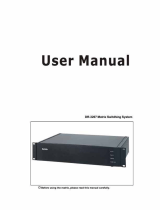
2 Pelco Manual C540M (6/98)
CONTENTS
Section Page
1.0 GENERAL ...............................................................................................5
1.1 IMPORTANT SAFEGUARDS AND WARNINGS ...............................5
1.2 CERTIFICATIONS .............................................................................5
2.0 DESCRIPTION ..........................................................................................6
2.1 MAIN FEATURES ..............................................................................6
2.2 MODELS............................................................................................6
2.3 PHYSICAL LAYOUT .......................................................................... 7
2.3.1 LCD Display ...........................................................................7
2.3.2 Multipurpose Function Keys ..................................................7
2.3.3 Keypad...................................................................................7
2.3.4 User Definable Control Keys..................................................7
2.3.5 Function Control ....................................................................8
2.3.6 Lens Control ..........................................................................8
3.0 INSTALLATION AND SETUP.....................................................................9
3.1 INSTALLATION ..................................................................................9
3.2 SETUP ...............................................................................................9
3.2.1 To Activate Setup Mode.........................................................9
3.2.2 To Leave Setup Mode ...........................................................11
3.2.3 Creating a Setup PIN............................................................11
3.2.4 Creating a Define PIN ...........................................................11
3.2.5 Calibrating the Joystick .........................................................11
3.2.6 Adjusting the Display Brightness ..........................................11
3.2.7 Direct Camera Control/Serial Port Speeds ...........................12
3.2.8 Configuring the Relays .........................................................13
3.2.9 User Definable Control Keys.................................................14
3.2.10 Setting Up a Receiver/Driver ................................................14
3.2.11 Downloading Keyboard Setups.............................................14
3.2.12 Assigning Logical Camera Numbers ....................................15
3.2.12.1 Downloading Keyboard to Keyboard.....................15
3.2.12.2 Downloading Through the CM9760 System .........16
3.2.13 Adjusting the Time-out Period...............................................16
3.3 DIAGNOSTICS MODE .....................................................................17
3.3.1 Testing the display ................................................................17
3.3.2 Testing the keys ....................................................................17
3.3.3 Testing the serial ports..........................................................17
3.3.4 Testing the dip switch............................................................17
4.0 OPERATION .............................................................................................18
4.1 INTRODUCTION ..............................................................................18
4.2 OVERVIEW .......................................................................................18
4.3 LOGGING ON...................................................................................18
4.4 LOGGING OFF .................................................................................19
4.5 SELECTING MONITORS .................................................................19
4.6 SELECTING CAMERAS...................................................................19
4.7 LOCKING CAMERAS OR INPUT DEVICES ....................................20
4.8 GROUP INPUT SELECTION............................................................20
4.8.1 Selecting Group Cameras ....................................................20
4.9 OPERATING PTZ CAMERAS...........................................................21
4.10 OVERRIDING CAMERA CONTROL ................................................21
4.11 OVERRIDING CAMERA LOCKS ......................................................21























